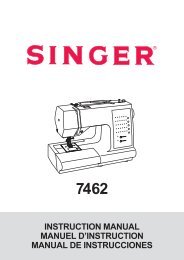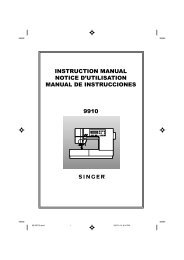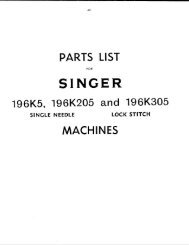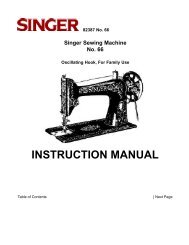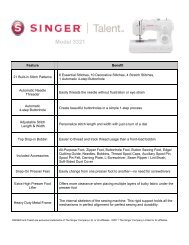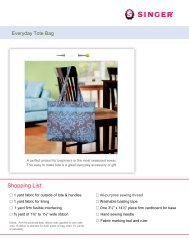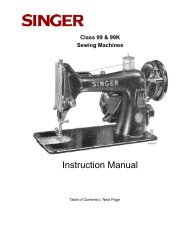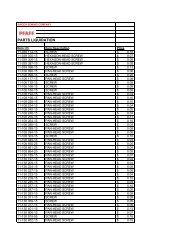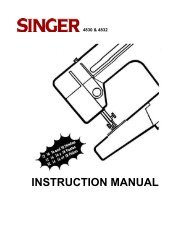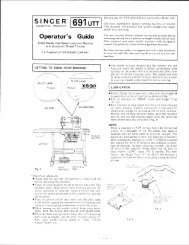Instruction Book Libro de Instrucciones Livret d'Instructions ... - Singer
Instruction Book Libro de Instrucciones Livret d'Instructions ... - Singer
Instruction Book Libro de Instrucciones Livret d'Instructions ... - Singer
You also want an ePaper? Increase the reach of your titles
YUMPU automatically turns print PDFs into web optimized ePapers that Google loves.
5 Flexi<br />
In addition to straight and zig-zag stitches, your<br />
machine can produce a variety of other<br />
patterns.<br />
Flexi stitches<br />
stitch<br />
patterns<br />
(only for machines with<br />
6, 8 and 10 stitches)<br />
These stitch patters are used for sewing knits<br />
and other stretch fabrics. Flexi Stitch patterns<br />
are ma<strong>de</strong> by the si<strong>de</strong> to si<strong>de</strong> movement of the<br />
needle along with the backward and forward<br />
movement of the feed.<br />
Stitch pattern selector<br />
Raise the needle to its highest position.<br />
Set the stitch width selector to the straight<br />
position ( ). (This allows the pattern selector<br />
to be moved easily).<br />
Sli<strong>de</strong> the pattern selector un<strong>de</strong>r the center of<br />
the <strong>de</strong>sired pattern grouping.<br />
Adjusting stitch length<br />
Turn the stitch length dial to the left until the<br />
mark ( ) on the dial lines up with the<br />
dot ( ) on the machine, as shown.<br />
Note: If for any reason the machine does not<br />
start sewing your <strong>de</strong>sired pattern after aligning<br />
the two dot symbols, push-in on the reverse<br />
stitch button.<br />
Diseños puntadas<br />
flexibles<br />
(solamente para máquinas con<br />
6,8y10mo<strong>de</strong>los 6, 8 y 10 mo<strong>de</strong>los <strong>de</strong> puntos)<br />
A<strong>de</strong>más <strong>de</strong> los puntos rectos y en zig-zag, su<br />
máquina pue<strong>de</strong> producir una variedad <strong>de</strong> otros<br />
diseños.<br />
Puntos flexibles<br />
Estos diseños <strong>de</strong> punto se utilizan para coser<br />
tejidos <strong>de</strong> <strong>de</strong> punto y otros extensibles. Los<br />
diseños <strong>de</strong> punto flexible flexible se producen por el<br />
movimiento <strong>de</strong> <strong>de</strong> la aguja aguja <strong>de</strong> <strong>de</strong> lado a lado y el el <strong>de</strong>l<br />
arrastre hacia atrás y a<strong>de</strong>lante.<br />
Selector diseño <strong>de</strong>l punto<br />
Suba la aguja a su posición más alta.<br />
Coloque el selector <strong>de</strong> anchura <strong>de</strong>l punto en la<br />
posición <strong>de</strong> recto ( ). Esto permitirá que el<br />
selector <strong>de</strong> patrón se mueva con facilidad.<br />
Deslice el selector <strong>de</strong> patrón hasta <strong>de</strong>bajo <strong>de</strong>bajo <strong>de</strong>l<br />
centro <strong>de</strong>l drupo <strong>de</strong> diseño requerido.<br />
Ajuste longitud <strong>de</strong>l punto<br />
Gire Gire el dial <strong>de</strong> longitud <strong>de</strong>l punto punto hacia la<br />
izquierda hasta que el indicador ( ) <strong>de</strong>l dial<br />
que<strong>de</strong> alíneado con el punto ( ) <strong>de</strong> la<br />
máquina, como se ilustra.<br />
Nota:<br />
Si por alguna razón la máquina no<br />
empieza empieza a coser el diseño requerido <strong>de</strong>spués<br />
<strong>de</strong> <strong>de</strong> alinear los dos puntos, presione sobre sobre el<br />
botón <strong>de</strong> <strong>de</strong> puntada reversible.<br />
Débuter une couture<br />
Positionnez le tissu sous le pied presseur.<br />
Alignez le bord droit le long <strong>de</strong> la ligne-gui<strong>de</strong><br />
choisie, baissez l’aiguille dans la ligne <strong>de</strong><br />
piqûre à 1cm du bord supérieur. Baissez le<br />
pied presseur.<br />
Appuyez sur le bouton <strong>de</strong> marche arrière situé au<br />
centre du sélecteur <strong>de</strong> longueur <strong>de</strong> point. Piquez<br />
jusqu’au bord du tissu en marche arrière pour<br />
renforcer le départ <strong>de</strong> la couture.<br />
Relâchez le bouton <strong>de</strong> marche arrière et piquez<br />
en avant.<br />
Gui<strong>de</strong>r et diriger le tissu<br />
La plupart <strong>de</strong>s tissus se gui<strong>de</strong>nt à l’avant du pied<br />
presseur. Certains tissus nécessitent quelques<br />
précautions pendant la couture.<br />
Pour le tricot et <strong>de</strong>s tissus similares, jerseys,<br />
synthétiques, maintenez-les à l’avant et à<br />
l’arrière du pied presseur sans tirer ni pousser<br />
le tissu.<br />
Les tissus extensibles doivent être fermement<br />
tendus à l’avant et à l’arrière du pied presseur<br />
pour détendre la couture.<br />
Couture en marche arrière<br />
Pour renforcer la fin <strong>de</strong> la couture, appuyez sur le<br />
bouton <strong>de</strong> marche arrière. Relevez l’aiguille et le<br />
pied presseur et dégagez le tissu en le tirant vers<br />
l’arrière sur la gauche. Coupez le fil à l’ai<strong>de</strong> du<br />
coupe-fil encastré dans la barre du pied<br />
presseur.<br />
54 35



